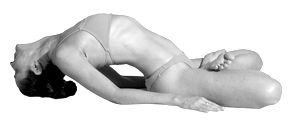Matsyasana on:
[Wikipedia]
[Google]
[Amazon]
 Matsyasana ( sa, मत्स्यासन; IAST: ''Matsyāsana'') or Fish pose is a reclining back-bending asana in hatha yoga and modern
Matsyasana ( sa, मत्स्यासन; IAST: ''Matsyāsana'') or Fish pose is a reclining back-bending asana in hatha yoga and modern
 * The legs can be kept straight on the ground, or with knees bent and feet on the floor, for practitioners unable to do Padmasana with the legs.
* The legs again straight can be lifted off the ground, for a "challenging variation".
* The hands may be placed before the heart in
* The legs can be kept straight on the ground, or with knees bent and feet on the floor, for practitioners unable to do Padmasana with the legs.
* The legs again straight can be lifted off the ground, for a "challenging variation".
* The hands may be placed before the heart in
Matsyasana
{{Hatha yoga Reclining asanas Medieval Hatha Yoga asanas Backbend asanas
 Matsyasana ( sa, मत्स्यासन; IAST: ''Matsyāsana'') or Fish pose is a reclining back-bending asana in hatha yoga and modern
Matsyasana ( sa, मत्स्यासन; IAST: ''Matsyāsana'') or Fish pose is a reclining back-bending asana in hatha yoga and modern yoga as exercise
Yoga as exercise is a physical activity consisting mainly of postures, often connected by flowing sequences, sometimes accompanied by breathing exercises, and frequently ending with relaxation lying down or meditation. Yoga in this form has ...
.
It is commonly considered a counterasana to Sarvangasana, or shoulder stand, specifically within the context of the Ashtanga Vinyasa Yoga Primary Series.
Etymology and origins
The name comes from the Sanskrit words ''matsya'' (मत्स्य) meaning "fish" and ''asana'' (आसन) meaning "posture" or "seat". The asana is medieval, described in the 17th century '' Gheraṇḍa Saṃhitā'' 2.21.Description
The asana is a backbend, where the practitioner lies on his or her back and lifts the heart ( anahata) chakra by rising up on the elbows and drawing the shoulders back. The neck is lengthened, and the crown of the headSahasrara
Sahasrara ( sa, सहस्रार, IAST: , en, "thousand-petalled", with many alternative names and spellings) or the crown chakra is considered the seventh primary chakra in some yoga traditions.
Hatha yoga
The Sahasrara is described ...
chakra is "pointed" toward the 'wall' behind the practitioner. As the arch of the back deepens with practice, and the heart and throat open further, the top of the head may brush the ground, but no weight should rest upon it.
Variations
 * The legs can be kept straight on the ground, or with knees bent and feet on the floor, for practitioners unable to do Padmasana with the legs.
* The legs again straight can be lifted off the ground, for a "challenging variation".
* The hands may be placed before the heart in
* The legs can be kept straight on the ground, or with knees bent and feet on the floor, for practitioners unable to do Padmasana with the legs.
* The legs again straight can be lifted off the ground, for a "challenging variation".
* The hands may be placed before the heart in Añjali Mudrā
Añjali Mudrā ( sa, अञ्जलि मुद्रा), is a hand gesture mainly associated with Indian religions and arts, encountered throughout Asia and beyond. It is a part of Indian classical dance postures such as Bharatanatyam, yoga p ...
, making the pose more difficult.
The pose can be supported with a bolster under the back, and with a cushion under the knees.
References
Further reading
* * *External links
Matsyasana
{{Hatha yoga Reclining asanas Medieval Hatha Yoga asanas Backbend asanas